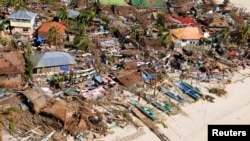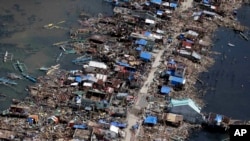Local police officials in the Philippines say the death toll in a central province that took the brunt of Typhoon Haiyan could reach as high as 10,000.
Provincial officials provided the estimate on Sunday after assessing damage in Leyte province, where they say the destruction was overwhelming. The regional police chief said most of the deaths resulted from drowning and collapsed buildings.
Philippine Interior Secretary Mar Roxas says it is difficult to describe the extent of damage in Leyte's capital, Tacloban.
"The devastation is — I do not have the words for it. It is really horrific. It is a great human tragedy. There is no power. There is no light."
U.N. emergency relief coordinator Valerie Amos said a U.N. disaster and assessment team that had been deployed to Tacloban found "scenes of total devastation." It said roads from the airport to the city of 200,000 people were impassable, leaving helicopters as the only means of travel.
The Associated Press says Tacloban's city administrator Tecson Lim told reporters as many as 400 bodies have been recovered.
Meanwhile, officials in Samar province say at least 300 people are known to have been killed on that island, with another 2,000 missing.
The death toll from some locations in the central Philippines is not yet known as communications have been knocked out by the powerful storm and land access is blocked by fallen trees and massive amounts of debris.
On Saturday, Tacloban residents wept as they recounted losing loved ones. Others appeared dazed. Bodies lay in the streets, covered in sheets and bags. People also began looting stores, looking for food to survive or carrying away household appliances.
The U.N. team leader Sebastian Rhodes Stampa said the last time he saw destruction on such a scale was in the aftermath of the December 2004 Indian Ocean Tsunami.
Super Typhoon Haiyan, known locally as Yolanda, made landfall Friday as one of the most powerful storms on record, with maximum sustained winds of about 300 kilometers an hour, sending waves up to five meters high crashing through island communities.
It is now in open water, churning towards Vietnam, where forecasters expect it to make landfall late Sunday or early Monday.
Vietnamese authorities have evacuated several hundred thousand people from coastal areas, where the storm's outer bands are already causing high winds and rough seas.
Separately, U.N. Secretary General Ban Ki-moon offered his condolences to the Philippines, saying he was deeply saddened by the "extensive loss of life."
The U.S. is assisting with relief efforts. In a Saturday statement, the Defense Department said the U.S. Pacific Command had been directed to assist in search and rescue operations and aircraft support.
Also, a U.S. relief team has been deployed to the region. The U.S. Agency for International Development says the team will conduct damage assessments, track conditions and "advise on additional needs."
The U.S. has also made $100,000 available for relief supplies, and the World Food Program is providing emergency assistance to government agencies that are helping victims.
Typhoon Haiyan weakened after crossing the Philippines but regained some strength as it began moving westward in the South China Sea.
The storm's new projected path also puts the southern Chinese island of Hainan at risk of strong winds and heavy rain. The Chinese government issued an alert to local authorities to prepare for flooding and called fishing boats back to port.
Provincial officials provided the estimate on Sunday after assessing damage in Leyte province, where they say the destruction was overwhelming. The regional police chief said most of the deaths resulted from drowning and collapsed buildings.
Philippine Interior Secretary Mar Roxas says it is difficult to describe the extent of damage in Leyte's capital, Tacloban.
"The devastation is — I do not have the words for it. It is really horrific. It is a great human tragedy. There is no power. There is no light."
U.N. emergency relief coordinator Valerie Amos said a U.N. disaster and assessment team that had been deployed to Tacloban found "scenes of total devastation." It said roads from the airport to the city of 200,000 people were impassable, leaving helicopters as the only means of travel.
The Associated Press says Tacloban's city administrator Tecson Lim told reporters as many as 400 bodies have been recovered.
Meanwhile, officials in Samar province say at least 300 people are known to have been killed on that island, with another 2,000 missing.
The death toll from some locations in the central Philippines is not yet known as communications have been knocked out by the powerful storm and land access is blocked by fallen trees and massive amounts of debris.
On Saturday, Tacloban residents wept as they recounted losing loved ones. Others appeared dazed. Bodies lay in the streets, covered in sheets and bags. People also began looting stores, looking for food to survive or carrying away household appliances.
The U.N. team leader Sebastian Rhodes Stampa said the last time he saw destruction on such a scale was in the aftermath of the December 2004 Indian Ocean Tsunami.
Super Typhoon Haiyan, known locally as Yolanda, made landfall Friday as one of the most powerful storms on record, with maximum sustained winds of about 300 kilometers an hour, sending waves up to five meters high crashing through island communities.
It is now in open water, churning towards Vietnam, where forecasters expect it to make landfall late Sunday or early Monday.
Vietnamese authorities have evacuated several hundred thousand people from coastal areas, where the storm's outer bands are already causing high winds and rough seas.
Separately, U.N. Secretary General Ban Ki-moon offered his condolences to the Philippines, saying he was deeply saddened by the "extensive loss of life."
The U.S. is assisting with relief efforts. In a Saturday statement, the Defense Department said the U.S. Pacific Command had been directed to assist in search and rescue operations and aircraft support.
Also, a U.S. relief team has been deployed to the region. The U.S. Agency for International Development says the team will conduct damage assessments, track conditions and "advise on additional needs."
The U.S. has also made $100,000 available for relief supplies, and the World Food Program is providing emergency assistance to government agencies that are helping victims.
Typhoon Haiyan weakened after crossing the Philippines but regained some strength as it began moving westward in the South China Sea.
The storm's new projected path also puts the southern Chinese island of Hainan at risk of strong winds and heavy rain. The Chinese government issued an alert to local authorities to prepare for flooding and called fishing boats back to port.













